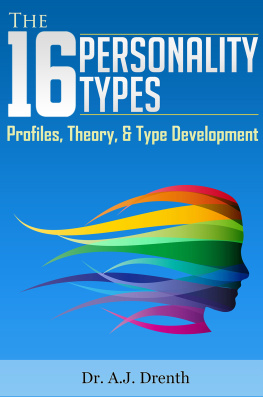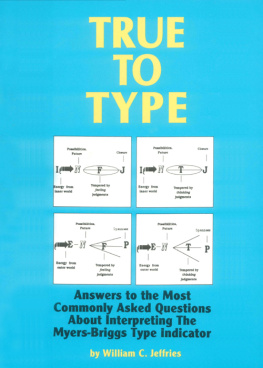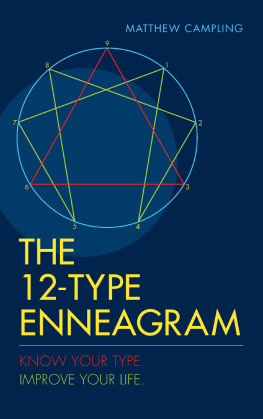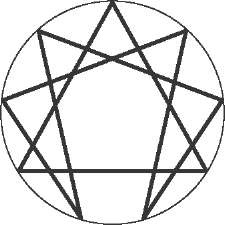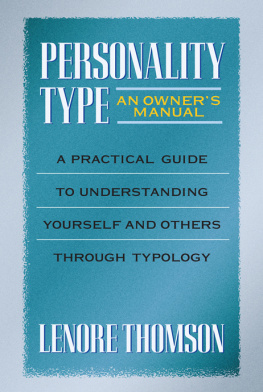1. Barriers to Effective Typing
Since identifying our true type is rarely as simple or straightforward as it seems, it is important to consider potential barriers or roadblocks to accurate typing. This will comprise our aim in this chapter. Specifically, we will consider the confounding role of nurture, personality development, and the inferior function in type identification. We will also touch on some potential shortcomings of personality tests with regard to accurate type diagnosis.
The Confounding Role of Nurture
One of the major barriers to accurate typing involves the confounding effects of nurture. By nurture, I am referring to the cumulative effects of past and present circumstancesculture, family, childhood, etc.on our personality.
Generally speaking, typology tells us much about the nature side of our personality, or what we might think of as our psychological DNA. It tells us very little, however, about the effects of nurture. So if we are willing to grant nature and nurture their respective contributions to the big picture of personality, which I think is entirely reasonable, we must conclude that typology is limited in its capacity to predict or explain the totality of our personality.
Although nurture does not change our basic personality type, it can in some ways cloud or impair our ability to accurately perceive our true type. Imagine, for instance, an extravert raised as an only child in a rural area, with no one but her parents to talk to. Such a child would seem far more likely to develop her introverted capacities than one raised with multiple siblings, which may in turn compromise her ability to grasp her true status as an extravert.
Jobs and careers may also leave their mark on our personality, as well as our perceptions of it. For example, working a highly structured job with predefined hours might cause perceiving types to resemble or see themselves as judgers. Similarly, unstructured work might lead judgers to fancy themselves perceivers.
In light of these examples, accurate typing requires that we effectively distinguish between nature (i.e., our true type) and nurture (i.e., the conditioned features overlaying and interlacing with our type). At minimum, this involves being able to distance ourselves from our present circumstances in order to better grasp the larger, historical picture of our type.
Personality Development
Our level of personal growth, or what is sometimes called type development, can also impact our ability to clearly recognize our type. In The 16 Personality Types, I discuss the three phases of type development for each of the personality types. Of these phases, Phase II is the most likely to derail our attempts at type diagnosis.
Phase II begins in late childhood and, for some people, may continue for decades. As the pressures and responsibilities involved with transitioning to adulthood grow more pronounced, we often experience a commensurate spike in identity confusion, and with it, type confusion. Further complicating matters, Phase II also entails a struggle for ascendancy between the dominant and inferior function. In short, because so much is happening in Phase II, both internally and externally, identity confusion and type confusion are commonplace.
The Inferior Function
In the previous chapter, we learned that the dominant function represents a types signature strength. While the dominant is the most conscious and well-developed of the functions, the mostly unconscious inferior function is in many respects its other half. Put together, they comprise a functional whole. And because the psyche desperately wants to be whole, all types are inclined to pursue, and to some degree identify with, their inferior function.
The reputed opposite of the dominant function, the inferior represents a new and exciting mode of existence. It is commonly experienced and described as intensely pleasurable, even magical. For example, when a thinking type with inferior feeling experiences powerful feelings of love or infatuation, he may feel hes been transported to a whole new world. Dominant feelers may experience something similar in moments of logical clarity.
Because of the power and allure of the inferior function, it contributes to no small amount of identity and type confusion. Indeed, for many of us, it is only after exploring and experimenting with the inferior function that we come to clearly recognize (or remember) who we really are (i.e., to accurately identify our dominant function). In this sense, we are like children who must make mistakes to learn our lessons. We must toy with, and even get burned by, the inferior before we remember and acknowledge our primary strength. And because most people have never even heard of the inferior function, it stands as one of the most insidious and overlooked sources of type confusion.
Shortcomings of Personality Assessments
Among the more common methods of type assessment is administering self-report questionnaires or personality tests. One of the more alluring features of personality tests is they provide a quick and objective result. Simply check some boxes, tabulate the results, and whoala! we have a type! Unfortunately, the effects of nurture, circumstances, personality development, the inferior function, and other factors may combine to create confusion in test responses. Clearly, there is a glut of information test-takers must sort through as they go about formulating their responses.
Making matters worse, personality tests themselves are far from perfect. Test-takers often feel that certain test items are unclear, misleading or confusing. Test items may also fail to measure the personality traits that most effectively represent or relate to ones type. Some questions may assess traits that vary widely among individuals of the same personality type. We encounter a similar problem in many descriptions and profiles of the types. Namely, when essential information is omitted, or non-essential information included, type confusion is bound to arise.
16. Type Structuring: What It Tells Us about EPs, EJs, IPs, & IJs
A couple years ago, my colleague Elaine Schallock developed the theory that, in the natural order of things, each personality type would move in a more or less sequential fashion through the functions in its functional stack over the course of a day. More specifically, each type would prefer to start the day engaging its dominant function, before eventually moving into its auxiliary, tertiary, and inferior.
Schallocks theory seems to hold true in my personal experience. My preference as an INTP is to work on my writing in the morning and, time permitting, well into the afternoon. Then once my mind fatigues or interest wanes, I naturally turn to S things like household chores, jogging, or yoga. By the time evening rolls around, Im often ready to engage with other people in conversation (Fe). Ive noticed the reverse trend in sensing types, who commonly enjoy exercising and completing physical tasks earlier in the day.
The point is we naturally gravitate toward our types strengths and preferences early in the day, when we are most refreshed and energized. Moreover, on days when we fail to exercise our core strengths, we often feel dissatisfied, sensing that something essential was left out.
If we apply this line of thinking to the functional stacks of EJs and IPs, these types would start their day in judging mode (Te, Fe, Ti, or Fi), eventually move into auxiliary and tertiary perceiving, and then finish in judging (inferior). EPs and IJs would display the opposite sequence, starting in perceiving (Se, Ne, Si, or Ni), eventually moving into judging, and then returning to perceiving. This prompted Schallock to classify EJs and IPs as J-P-J types and EPs and IJs as P-J-P types.


